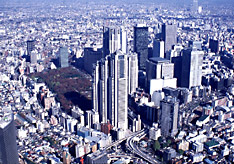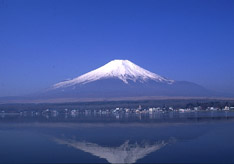| |
Geography
The Japanese archipelago lies off the eastern coast of the Asian continent ranging from about 20 degrees to 45 degrees north. There are four main islands: Hokkaido, Honshu, Shikoku and Kyushu, plus thousands of other smaller islands. Honshu accounts for about 60 per cent of the total area. The combined land area is approximately 378,000 square kilometers of which 14 per cent is used for agricultural purposes, 66 per cent is forests and 20 per cent for other uses. By land mass Japan is slightly larger than the UK. Tokyo is on about the same latitude as Athens and Los Angeles
Related sites:
Japan Fact Sheet
Japan Atlas
|
Capital
Tokyo has been the capital of Japan since 1868. Located on the Kanto plain on the Pacific coast of Honshu, it is one of the world's largest and most densely populated areas. Area: 2,187 square kilometres; population: 12,064,000 (2000). Tokyo is the seat of Japan's National Government and home to the Imperial Family. It is a city rich in cultural diversity, and as Japan's economic centre, it is an international magnet for business.
Related site: Tokyo Past and Present
|

|
Population
At the most recent census (October 2001), Japan's population stood at 127.4 million, ninth largest in the world. The population density is 340 per square kilometre, although since a large amount of the land is uninhabitable, the density in inhabited areas is much higher. About one quarter of the population live around the Tokyo Metropolitan area.
|
Climate
The islands of Japan lie in the temperate and at the north eastern end of the monsoon area. The climate is generally mild, although it varies considerably from place to place. Summer, which is warm and mild, begins around the middle of July following a rainy season that usually lasts for a month. Except in northern Japan the winter is mild with many sunny days. Spring and Autumn are the best seasons of the year with balmy days and bright sunshine. September is typhoon season. The mean temperatures, humidity and rainy days during the four seasons in four areas are as below.
Related site: Japan Fact Sheet
Topography
Japan sits on top of the convergence point of several tectonic plates making it highly susceptible to earthquakes. In 1995 the Great Hanshin Earthquake took the lives of over 6300 people. There are also 77 active volcanoes, including the 3776 metre tall Mount Fuji. However, "Fuji-san" has not erupted since 1707. The volcanoes also provide Japan with one of the most popular pastimes, onsens, or hot springs of which there are thousands all over the country.
|

|
| Top |
|
| |
|
|


